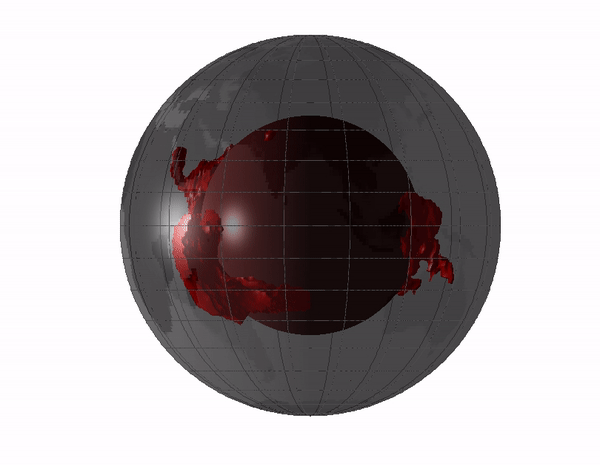In a new study under review for publication in "Geophysical Research Letters", scientists have come up with a new model that explains where the giant and mysterious masses of rock found in the depths of the lower parts of the mantle of planet Earth, which were observed with a seismic tomography, came from.
These anomalies are called "large low-shear-velocity provinces-LLSVPs", and there are two of them, one buried under the African continent, the other under the Pacific Ocean.
It is made up of dense rocks that are among the largest and strangest structures on Earth.
The presence of these structures inside the mantle raised many questions for scientists, such as how and the reasons behind their appearance, despite the presence of some answers;
However, there is little concrete evidence.
Visualization of a collision between Theia and Earth, which may have formed the moon (NASA)
What scientists know
These anomalous structures are very massive and thus generate their own perturbations, such as the large phenomenon currently developing within the Earth's magnetic field and weakening it, known as the South Atlantic anomaly.
What scientists know so far is that these giant rocks have been around for a very long time, as many believe that they were part of the Earth since before the hypothesis of the giant collision, which occurred between the planet Earth and the hypothetical planet, which is called "Theia" , And this collision gave birth to the moon.
According to this widely spread theory, Thea, a planet the size of Mars, struck early Earth about 4.5 billion years ago, and the moon formed from the scattered fragments resulting from the collision between the two planets.
As for what happened to the rest of Theia, it is unknown and uncertain whether it was destroyed, or whether it simply reverted to deep space, no one knows.
Some researchers suggest that the nuclei of these two primitive planets may have merged into a single planet, and that it was the chemical reactions resulting from this epic fusion that enabled life itself to flourish in the resulting world.
New proposal
In the new study, conducted by researchers from Arizona State University, scientists concluded a new proposal, which may answer ambiguities regarding LLSVPS structures, and the idea of weaving them with the hypothesis of fusion of the two nuclei of both Planet Earth and the hypothetical planet Theia.
According to new modeling by the researchers, LLSVPS may represent ancient fragments of the extremely dense and iron-rich Theia mantle, which sank deep into the Earth's mantle when the two developing planets came together, and were buried there for billions of years.
Qian Yuan, first author of the study who studies mantle dynamics at Arizona State University, explains in the summary of the research team's findings, "The gigantic collision hypothesis is one of the most tested models for moon formation; but direct evidence indicates the existence of Thea Ma. Still elusive. "
"We have shown that the Thea mantle may be substantially denser than the Earth's mantle, enabling the material of the Thea mantle to sink into the Earth's lower mantle, and build up in thermal chemical piles that could cause the earthquake-detected LLSVPS"
An animation showing massive rock structures as inferred (Sen Kotar - Wikipedia)
And despite the existence of previous speculation and for years that the giant "LLSVPS" rocks may be a strange souvenir that the hypothetical planet Theia implanted on our planet;
However, the new research is the most comprehensive format so far.
The results of the research were presented at the 52nd Lunar and Planetary Science Conference-LPSC, which was held online from 15 to 21 March.

